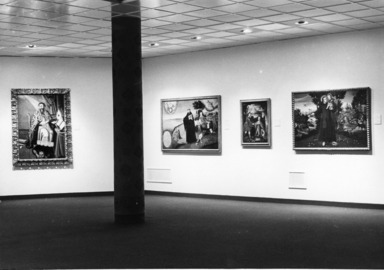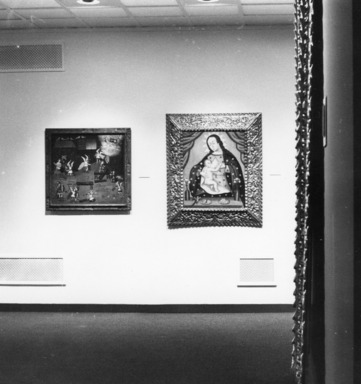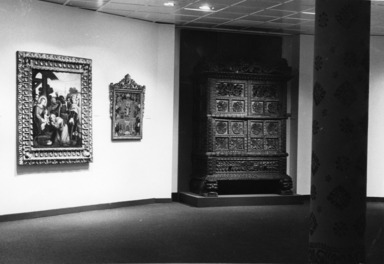

Peruvian Colonial Painting, December 08, 1971 through January 23, 1972 (Image: PSC_E1971i001.jpg Brooklyn Museum photograph, 1971)

Peruvian Colonial Painting, December 08, 1971 through January 23, 1972 (Image: PSC_E1971i002.jpg Brooklyn Museum photograph, 1971)

Peruvian Colonial Painting, December 08, 1971 through January 23, 1972 (Image: PSC_E1971i003.jpg Brooklyn Museum photograph, 1971)

Peruvian Colonial Painting, December 08, 1971 through January 23, 1972 (Image: PSC_E1971i004.jpg Brooklyn Museum photograph, 1971)

Peruvian Colonial Painting, December 08, 1971 through January 23, 1972 (Image: PSC_E1971i005.jpg Brooklyn Museum photograph, 1971)

Peruvian Colonial Painting, December 08, 1971 through January 23, 1972 (Image: PSC_E1971i006.jpg Brooklyn Museum photograph, 1971)

Peruvian Colonial Painting, December 08, 1971 through January 23, 1972 (Image: PSC_E1971i007.jpg Brooklyn Museum photograph, 1971)

Peruvian Colonial Painting, December 08, 1971 through January 23, 1972 (Image: PSC_E1971i008.jpg Brooklyn Museum photograph, 1971)

Peruvian Colonial Painting, December 08, 1971 through January 23, 1972 (Image: PSC_E1971i009.jpg Brooklyn Museum photograph, 1971)

Peruvian Colonial Painting, December 08, 1971 through January 23, 1972 (Image: PSC_E1971i010.jpg Brooklyn Museum photograph, 1971)

Peruvian Colonial Painting, December 08, 1971 through January 23, 1972 (Image: PSC_E1971i011.jpg Brooklyn Museum photograph, 1971)

Peruvian Colonial Painting, December 08, 1971 through January 23, 1972 (Image: PSC_E1971i012.jpg Brooklyn Museum photograph, 1971)

Peruvian Colonial Painting, December 08, 1971 through January 23, 1972 (Image: PSC_E1971i013.jpg Brooklyn Museum photograph, 1971)

Peruvian Colonial Painting, December 08, 1971 through January 23, 1972 (Image: PSC_E1971i014.jpg Brooklyn Museum photograph, 1971)

Peruvian Colonial Painting, December 08, 1971 through January 23, 1972 (Image: PSC_E1971i015.jpg Brooklyn Museum photograph, 1971)

Peruvian Colonial Painting, December 08, 1971 through January 23, 1972 (Image: PSC_E1971i016.jpg Brooklyn Museum photograph, 1971)

Peruvian Colonial Painting, December 08, 1971 through January 23, 1972 (Image: PSC_E1971i017.jpg Brooklyn Museum photograph, 1971)

Peruvian Colonial Painting, December 08, 1971 through January 23, 1972 (Image: PSC_E1971i018.jpg Brooklyn Museum photograph, 1971)

Peruvian Colonial Painting, December 08, 1971 through January 23, 1972 (Image: PSC_E1971i019.jpg Brooklyn Museum photograph, 1971)

Peruvian Colonial Painting, December 08, 1971 through January 23, 1972 (Image: PSC_E1971i020.jpg Brooklyn Museum photograph, 1971)

Peruvian Colonial Painting, December 08, 1971 through January 23, 1972 (Image: PSC_E1971i021.jpg Brooklyn Museum photograph, 1971)

Peruvian Colonial Painting, December 08, 1971 through January 23, 1972 (Image: PSC_E1971i022.jpg Brooklyn Museum photograph, 1971)

Peruvian Colonial Painting, December 08, 1971 through January 23, 1972 (Image: PSC_E1971i023.jpg Brooklyn Museum photograph, 1971)
Peruvian Colonial Painting
-
December 1, 1971
Exhibit of 17th & 18th Century Peruvian Art To Travel To Texas and New Orleans After January 23 Closing
The rich Baroque folk art created by unknown Indian artists of colonial Peru goes on view at the Brooklyn Museum on December 9. Comprised of forty-three paintings, the Brooklyn Museum show of PERUVIAN COLONIAL PAINTING is the largest exhibition of work from this particular culture ever to be held in this country. Built around twenty-six paintings from the collection of the Stern Fund and Mr. and Mrs. Arthur Q. Davis, which have never been shown publicly before, PERUVIAN COLONIAL PAINTING also includes seventeen works chosen from the Museum’s own Peruvian collection. Selected examples of indigenous furnishings as well as a special Introductory Gallery, analyzing the paintings in terms of their artistic sources and historical context, augments this unusual exhibition.
Labels and explanatory text for PERUVIAN COLONIAL PAINTING will be in Spanish and English and admission is free. The exhibition will be on view through January 23, 1972 in the Robert E. Blum Gallery.
Primarily religious in theme, these fresh and appealing paintings are the work of anonymous craftsmen from Cuzco, the ancient mountain capital of the Incas. By the 17th century, Cuzco had become one of the primary centers for the production of paintings needed for the many new churches springing up in the Andean region. Drawing upon their own colorful artistic heritage to celebrate the Catholic tradition learned from their Spanish conquerors, the Peruvian Indians created a genuinely new art style. While the paintings reflect their European models in theme, costume and narrative, their fresh color and delightful decorative quality are unique to Peru.
An outstanding example is CHRIST CHILD WITH SYMBOLS OF THE PASSION, a fusion of the late Renaissance, the Spanish Baroque, and the late medieval imagery, all composed into a single fresh, sweet figure surrounded by typical vases and garlands of flowers.
The works shown in PERUVIAN COLONIAL PAINTING originally hung as altar pieces or separate paintings on the walls of churches, and such exhibitions of Peruvian paintings are therefore comparatively rare. The Brooklyn Museum owes the founding of its own Peruvian painting collection to Dr. Herbert Spinden, a former curator of Primitive Arts at the Museum, whose curatorial knowledge and interest embraced both pre-Columbian and Indo-Hispanic art.
A fully illustrated 112 page catalogue, written by Pal Kelemen, an early pioneer in Latin American studies, is available at the exhibition and in the Museum bookshop for $4.00.
When PERUVIAN COLONIAL PAINTING closes in the Brooklyn Museum on January 23, 1972, it will travel to the Art Gallery of the University of Texas at Austin, Texas, and the Delgado Museum, in New Orleans, Louisana.
Brooklyn Museum Archives. Records of the Department of Public Information. Press releases, 1971 - 1988. 1971, 050-51.
View Original

